|
|
|
Sort Order |
|
|
|
Items / Page
|
|
|
|
|
|
|
| Srl | Item |
| 1 |
ID:
181835
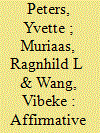

|
|
|
|
|
| Summary/Abstract |
While the increase of women in elected office has received much scholarly attention, less attention has been paid to the dynamics of resisting gender quotas in countries that fail to adopt such measures despite regional and international pressure. We develop a context-sensitive typology of affirmative action measures that includes gender quotas and funding incentives and explore determinants of electoral candidates’ positioning in the context of Zambia. Using a sequential mixed-methods approach and unique data, we examine how candidates of different gender, party affiliation, and level of electoral success position themselves when asked to choose between different options. Intriguingly, electoral success and party allegiance – whether a candidate is affiliated with a current or former government party – are more important than gender. This finding is relevant for the debate on feminist democratic representation by showing that candidates are likely to have their more radical views muted when getting into position.
|
|
|
|
|
|
|
|
|
|
|
|
|
|
|
|
| 2 |
ID:
172565
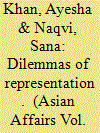

|
|
|
|
|
| Summary/Abstract |
Recognizing constraints Pakistani women legislators face despite their entry into politics on a 17 per cent quota in national and provincial assemblies, it is time to rethink how quotas can lead to their political mainstreaming. This article explores quota legislators' views on their own accountability and empowerment based on the first online survey in Pakistan with 200 women in the assemblies (2013-18). Findings show quota legislators resist classification as male proxies and view themselves as accountable to notional voters, although they are indirectly elected. Many report silencing and harassment by male colleagues. Cross-party women's caucuses in each assembly have a mixed track record of facilitating substantive representation, undermined by religious parties and class differences. Respondents favoured further affirmative action mechanisms to increase their political voice, e.g. additional quota requirements within parties, more tickets for general seats and participation in key decision-making bodies of parties. A trajectory for women in politics to move from quota seats (in local bodies and assemblies) to general seats is not yet in place.
|
|
|
|
|
|
|
|
|
|
|
|
|
|
|
|
| 3 |
ID:
145755
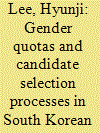

|
|
|
|
|
| Summary/Abstract |
South Korea is one of the few East Asian countries in which candidate gender quotas are legislated for all levels of government. However, the implementation of quotas has been only partially successful as political parties do not comply with quota laws in the majoritarian tier of the country’s mixed-member electoral system. To explain this non-compliance, this article examines how Korea’s party organizations and candidate selection practices have subverted quota implementation. More specifically, we employ Rahat and Hazan’s framework that disaggregates candidate selection processes into four areas—the selectorate, candidacy, centralization, and voting vs. appointment—and examine how two major Korean parties have chosen their candidates in the last three elections. By doing so, we demonstrate that in Korea’s under-institutionalized parties, where party organizations have been overshadowed by individual personalities, implementation of quotas can easily be subordinated to the clientelistic incentives of party leaders. While the parties’ centralized and exclusionary candidate selection procedures give party leaders a great deal of latitude to implement quotas, a better gender balance in the set of candidates is rarely a top priority for leaders in parties where personalism prevails. We argue that this explains why the quotas in Korea have been ineffective.
|
|
|
|
|
|
|
|
|
|
|
|
|
|
|
|
| 4 |
ID:
145088
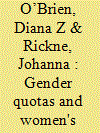

|
|
|
|
|
| Summary/Abstract |
Though more than 100 countries have adopted gender quotas, the effects of these reforms on women's political leadership are largely unknown. We exploit a natural experiment—a 50–50 quota imposed by the national board of the Swedish Social Democratic Party on 290 municipal branches—to examine quotas’ influence on women's selection to, and survival in, top political posts. We find that those municipalities where the quota had a larger impact became more likely to select (but not reappoint) female leaders. Extending this analysis, we show that the quota increased the number of women perceived as qualified for these positions. Our findings support the notion that quotas can have an acceleration effect on women's representation in leadership positions, particularly when they augment the pool of female candidates for these posts. These results help dispel the myth that quotas trade short-term gains in women's descriptive representation for long-term exclusion from political power.
|
|
|
|
|
|
|
|
|
|
|
|
|
|
|
|
| 5 |
ID:
145753
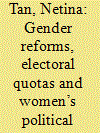

|
|
|
|
|
| Summary/Abstract |
In the last two decades, more than 118 countries and political parties around the world have introduced gender quotas to guarantee women’s political representation. While the study of gender quotas and electoral systems is an exciting field, few studies have focused on East Asia. Why do traditionally male-dominated parties engage in gender reforms? Have gender reforms improved women’s political representation and participation? To address these questions, this introductory article offers an overview of the electoral rules, gender quotas, and candidate selection methods adopted in three broadly similar cases with different outcomes in Taiwan, South Korea, and Singapore. Taiwan and South Korea introduced mixed electoral systems and legislated candidate quotas to improve women’s legislative representation at the local and national levels. Singapore resisted legislating gender quotas while the ruling party voluntarily introduced a party quota in 2009. These gender equality strategies have brought slow and uneven results. Based on qualitative and quantitative methods as well as survey and electoral data, this paper offers new evidence showing why the effects of electoral systems and quota strategies are not automatic or mechanical, but dependent on the degree of party system institutionalization, electoral competitiveness, legal enforcement, and social-cultural attitudes toward women.
|
|
|
|
|
|
|
|
|
|
|
|
|
|
|
|
| 6 |
ID:
167048
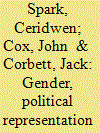

|
|
|
|
|
| Summary/Abstract |
Increasing women’s representation in national legislatures has become a priority for international organisations and aid donors in recent decades. Existing studies emphasise structural barriers, whether economic, cultural or religious, that inhibit women’s participation in the public sphere. Little attention is paid to women who defy these barriers to win election in contexts that are hostile to their presence. This article addresses this gap. Using a Bourdieusian approach, it shows how three senior women leaders from the Pacific Islands translate symbolic capital into political capital. For donors and would-be reformers, the lesson is that institutional interventions must be implemented in ways which allow women’s symbolic capital to be deployed as political capital, or which enhance women’s control of various forms of capital. This message is particularly relevant for those interested in the capacity of quotas and other temporary measures to translate descriptive representation into substantive developmental gains.
|
|
|
|
|
|
|
|
|
|
|
|
|
|
|
|
| 7 |
ID:
145754
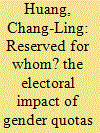

|
|
|
|
|
| Summary/Abstract |
Since the 1990s, gender quotas in elections have become a global phenomenon.
One of the issues raised about gender quotas concerns the qualifications of quota women. A previous study that looked at France’s parity law showed quota women are as competent as or even more competent than non-quota women or non-quota men. The French experience, under the proportional representation system, only allows for a comparison of average qualifications between quota women and their non-quota counterparts.
|
|
|
|
|
|
|
|
|
|
|
|
|
|
|
|
| 8 |
ID:
139535


|
|
|
|
|
| Summary/Abstract |
The rapid global spread of quotas for women constitutes one of the most significant political developments of the last thirty years. It transformed the composition of legislatures worldwide. Yet we lack a solid understanding of the forces driving quota diffusion. In this article, we consider how global pressure from the international women's movement affects national gender quota adoption. In the first quantitative analysis of this question on a global scale, we use event history techniques to examine global, transnational, and national influences on quota adoption in 149 countries between 1989 and 2008. Contributing to work on international norm diffusion, we find a crucial role for women's activism, but uncover a negative interaction between increased global pressures and domestic ties to women's transnational organizing. We suggest global pressure to adopt quotas may be weakened by the diverse agendas of women's activist organizations, by perceived threats to male elites posed by women's agitation, or both.
|
|
|
|
|
|
|
|
|
|
|
|
|
|
|
|
|
|
|
|
|